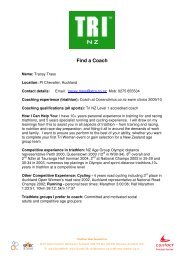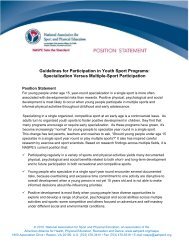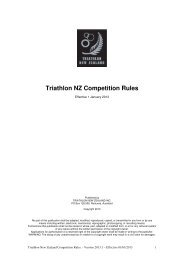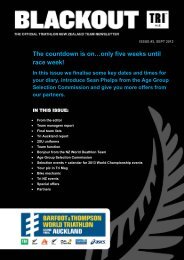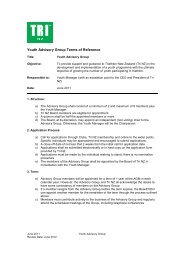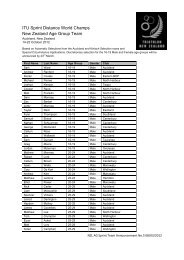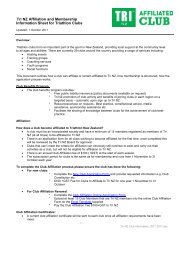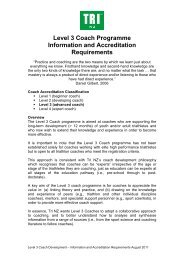The Science of Cycling - IngentaConnect
The Science of Cycling - IngentaConnect
The Science of Cycling - IngentaConnect
Create successful ePaper yourself
Turn your PDF publications into a flip-book with our unique Google optimized e-Paper software.
<strong>The</strong> <strong>Science</strong> <strong>of</strong> <strong>Cycling</strong>: Part 1 301<br />
Table IX. Training protocol employed by the German national<br />
4000m pursuit team during the last 19 days prior to the 2000<br />
Olympic Games [142]<br />
No. <strong>of</strong> days to Training<br />
competition<br />
15–19 Stage race<br />
14 Rest day<br />
13 115km basic training<br />
cling disciplines within the national team (road,<br />
track, mountain-bike training). For riders using the<br />
SRM system, these zones are given in watts (Schumacher<br />
YO, personal communication).<br />
10.4 Interval Training<br />
12<br />
11<br />
120km basic training<br />
115km basic training<br />
Cyclists traditionally use increases in training<br />
volume to induce an overload in the training stimulus.<br />
When a rise in volume no longer augments<br />
10 120km basic training<br />
9 Rest day<br />
fitness, cyclists employ intervals to intensify their<br />
8 Track training 3 × 5000m evolution training<br />
training load. Hawley et al. [143] have suggested that<br />
7 Morning 3 × 5000m evolution training<br />
Afternoon 4 × 5000m evolution training<br />
following the base training period, endurance athletes<br />
undergo a period <strong>of</strong> transition training, which<br />
6 2 × 5000m evolution training<br />
1 × 2000m, 1 × 1000m ‘peak’ training entails the use <strong>of</strong> ‘pace’ type intervals. Accordingly,<br />
5<br />
4<br />
3<br />
75m basic training/recovery (road)<br />
Morning 2 × 5000m evolution training<br />
Afternoon 1h basic training (road)<br />
3 × 5000m evolution training<br />
2 × 2000m peak training<br />
when high-intensity intermittent training is adopted,<br />
the selection <strong>of</strong> the most effective work and rest<br />
ratios <strong>of</strong> the exercise bouts must be addressed.<br />
Toward that end, MacDougal et al., [144] examined<br />
the effects <strong>of</strong> cycling sprint interval training on<br />
2 75m basic training/recovery (road)<br />
muscle glycolytic and oxidative enzyme activity and<br />
1 2 × 5000m evolution training<br />
exercise performance. Training consisted <strong>of</strong> 30-second<br />
maximum sprint efforts (Wingate protocol) ineter<br />
using the HR at the individual anaerobic thresh- terspersed by 2–4 minutes <strong>of</strong> recovery, performed<br />
old (IAS) as the main marker. Basic training ranges three times per week for 7 weeks. <strong>The</strong> training<br />
between HR (IAS) – 50 beats/min and HR (IAS) – programme began with four intervals with 4 minutes<br />
30 beats/min. For example, an athlete with an HR <strong>of</strong> <strong>of</strong> recovery per session in week 1 and progressed to<br />
165 beats/min at IAS should perform his basic train- ten intervals with 2.5 minutes <strong>of</strong> recovery per sesing<br />
at intensities between 115 and 135 beats/min. sion by week 7. This training strategy resulted in<br />
This training is aimed at pure aerobic adaptation. significant increases in Wpeak, total work over<br />
Training units last from 2 to 7 hours (60–240km) 30 seconds and ˙VO2max. Moreover, maximal enand<br />
are usually performed on the road (Schumacher zyme activity, sampled from the vastus lateralis, <strong>of</strong><br />
YO, personal communication).<br />
hexokinase, phosph<strong>of</strong>ructokinase, citrate synthase,<br />
Furthermore, ‘evolution training’ is calculated in succinate dehydrogenase and malate dehydrogenase<br />
a similar way: HR (IAS) – 5 beats/min and HR at was also significantly higher following training.<br />
(IAS) + 5 beats/min. (160–170 beats/min in the <strong>The</strong>se findings clearly demonstrate that relatively<br />
above-mentioned example). It ranges around the brief but intense sprint training can enhance both<br />
IAS and therefore aims at improving lactate toler- glycolytic and oxidative enzyme activity, maximum<br />
ance. Evolution training is usually performed after a short-term power output and ˙VO 2max. Tabata et<br />
period <strong>of</strong> basic training, closer to the competition. al. [145] found that a high-intensity intermittent train-<br />
Intervals with or without full recovery (intensive/ ing programme achieved bigger gains in ˙VO2max<br />
extensive) are usually used for this type <strong>of</strong> training. (+9%) than a programme <strong>of</strong> 60 minutes <strong>of</strong> moder-<br />
<strong>The</strong> length is between 3 and 10km or 3 and 15 ate-intensity cycling (70% ˙VO2max) for a total <strong>of</strong> 5<br />
minutes. Training can be performed on the road or hours per week for 6 weeks. <strong>The</strong> short-term, highdiscipline-specific<br />
on the track or mountain-bike intensity training sessions consisted <strong>of</strong> eight all-out<br />
training. <strong>The</strong>se training zones are used for all cy- work bouts, each lasting 20 seconds, with 10<br />
© 2005 Adis Data Information BV. All rights reserved. Sports Med 2005; 35 (4)



